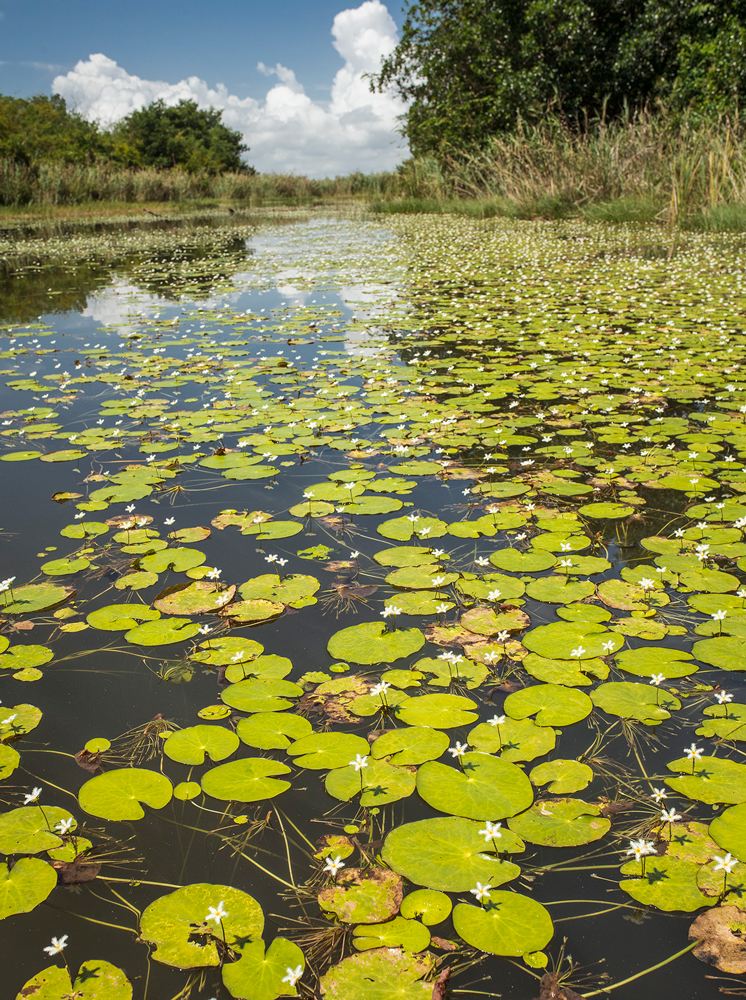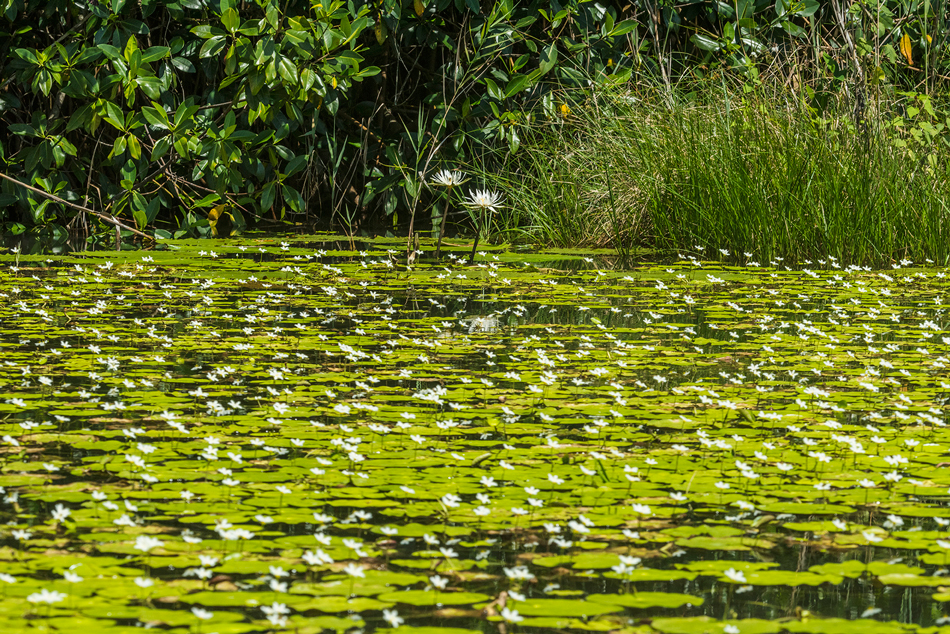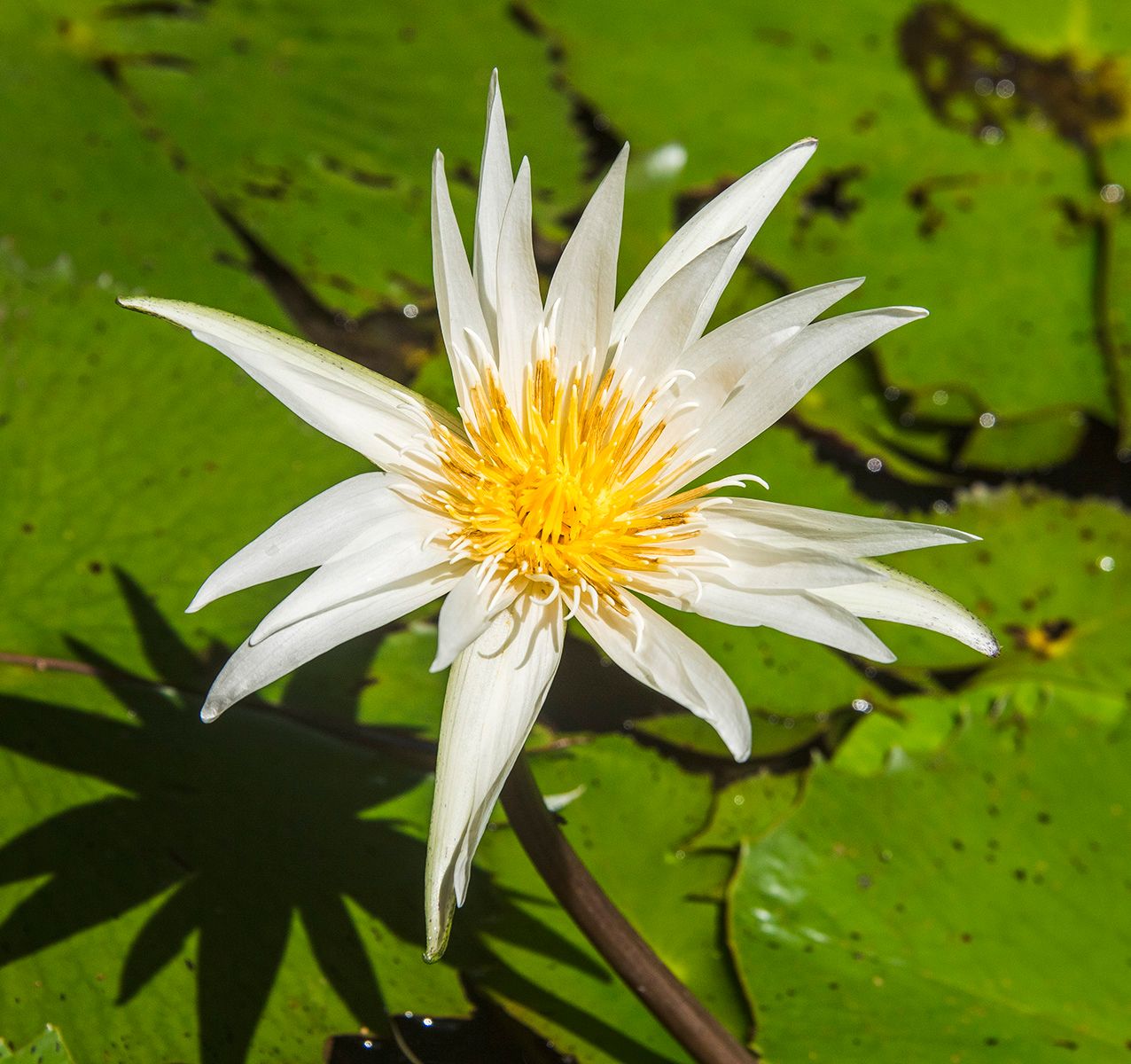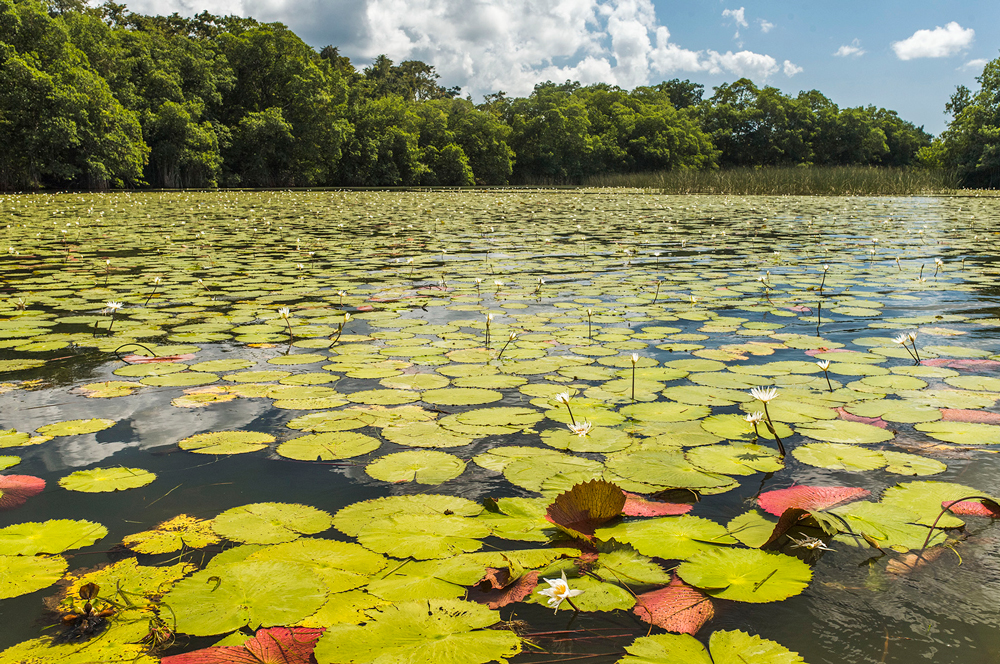Nymphoides indica is rare in Guatemala but common in Izabal area
In the many decades that I have been studying waterlily plants in Guatemala, the primary species I have focused on is Nymphaea alba. That’s because this is the waterlily that appears on stelae of Copan, stelae of Guatemala, murals of Bonampak, ceramic Maya plates, bowls, and vases, especially of the Late Classic (Tepeu 1 and Tepeu 2). So in all these years of field work in rivers, creeks, lakes, lagoons, and swamps in Peten, Izabal, and near Monterrico, I have not focused on the other waterlily, Nymphoides indica.
But during our second monthly field trip to Izabal, working in cooperation with the Municipio de Livingston team, the helpful boat captain and local guides brought us to areas where we found thousands of Nymphoides indica in full flowering phase during the middle of March, 2020.
Large area with both Nymphoides indica by themselves: no Nymphaea alba among the Water Snowflake flowers.
Photo by David Arrivillaga using a Nikon D5 camera and a lens 35mm f/1.4 at El Golfete, Municipo de Izabal, Guatemala. Settings: 1/500 sec, f/11, ISO 640.
Nymphoides indica also growing in exactly same habitat as Nymphaea ampla
Large area with both Nymphoides indica and also Nymphaea ampla, growing happily together.
Photo by Nicholas Hellmuth using a Nikon D810 camera, lens 200mm f/4, in El Golfete. Settings: 1/1000 sec, f/11, ISO 640.
In other parts of the wetlands of Rio Dulce, especially on the north side and south side of El Golfete our helpful local guides showed us areas where the Nymphoides indica grow side by side together with the larger Nymphaea alba waterlilies.
Photo by David Arrivillaga using a Nikon D5 and a Nikon 28-300mm lens. Settings: 150mm, 1/1000 sec, f/10, ISO 640.
Other areas of solid Nymphaea alba, with not one single Nymphoides indica
We hope a botanist or ecologist can come to these areas and study the local soil and other aspects (water depth perhaps) to learn why some areas are solid Nymphaea ampla; other areas are solid Nymphoides indica and other areas have the two flowering water plants next to each other.
Photo by David Arrivillaga using a Nikon D5 and a Nikon 35mm lens. Settings: 150mm, 1/1000 sec, f/10, ISO 640.
We look forward to studying the entire circumference of El Golfete (in March we studied both north and south of the east end (towards the Rio Dulce Canyon to Livingston). In late April we would like to search the entire west end of El Golfete, the entire Rio Dulce from there to the west side of the highway bridge, to Lake Izabal, to see which areas have Nymphoides indica, which areas have Nymphaea alba and which habitats have both together.
We will also be looking for all other water plants that are visible on the surface, such as Wolffia brasiliensis, Lemna minor, etc. The plants of the Mayan word are very remarkable.
Bibliography, References Cited and Suggested Reading on Nymphoides indica
Very few web sites have meaningful information on Nymphoides indica.
Most REA and Plan Maestro reports simply list Nymphoides indica (if anyone has been going deep enough into the swamps to find it). But even if listed, practically no viable information is available on its habitat. Fortunately capable Mexican botanists have produced two helpful reports.
- 2003
- Los tratamientos populares y el personal de salud. Mexico.
- 2000
- Checklist of the Vascular Plants of Belize: With Common Names and Uses. Memoirs of the New York Botanical Garden Vol. 85. 246 pages.
- 2015
- Messages from the Gods: A Guide to the Useful Plants of Belize. The New York Botanical Garden, Oxford University Press.
- 2005
- Biodiversidad del Estado de Tabasco. CONABIO, UNAM, Mexico. 370 pages.
- 2008
- Resolucion 401/2008. CONAP, Guatemala.
- 2001
- Inventario Nacional de los Humedales de Guatemala. UICN-Mesoamérica: CONAP: USAC.
Curiously “published” in San Jose, Costa Rica, although everything in the book is focused on Guatemala.
Has nice list of major lakes and large rivers of Guatemala. but is missing 100% of the rivers and “creeks” of the Izabal area (other than large rivers such as Rio Dulce and Rio Polochic). Also does not have Rio Ixtinto for Peten. Nor even the Rio Holmul. I also expected this monograph to have lists of all the water plants of all the humedales. But after looking hour after hour I see that it is a list of the big lakes and big rivers: it is not a list of ecosystems, habitats, nor water plants whatsoever. Would be great to do a 2nd Edition by adding the missing information.
- 2010
- Indicadores ecológicos de la zona riparia del río San Pedro, Tabasco, México. MS Thesis, El Colegio de la Frontera Sur. 131 pages.
Free Download:
https://ecosur.repositorioinstitucional.mx/jspui/bitstream/1017/1656/1/100000050585_documento.pdf
- 2011
- Dietary use and conservation concern of edible wetland plants at Indo-Burma hotspot: a case study from Northeast India. Journal of Ethnobiology and Ethnomedicine, 7: 29.
Free Download:
www.ncbi.nlm.nih.gov/pmc/articles/PMC3207871/pdf/1746-4269-7-29.pdf/?tool=EBI
- 2015
- Guia ilustrada de campo. Plantas Indicadoras de Humedales. UNAM. Mexico
Free Download:
www.gob.mx/cms/uploads/attachment/file/102190/Gu_a_PIH-min.pdf
- 2015
- Guia ilustrada de campo. Plantas Indicadoras de Humedales. UNAM. Mexico
Free Download:
www.gob.mx/cms/uploads/attachment/file/102190/Gu_a_PIH-min.pdf
- 1937
- The Vegetation of Peten. Carnegie Institution of Washington, Publ. 478. Washington. 244 pages.
Not one species of Nymphoides is findable. No plant of Family Menyanthaceae. Lundell produced priceless botanical information, but he was primarily a tree and shrub person. But yet he does list Nymphaea alba dozens of times since this plant is everywhere and easily visible. And, as a pleasant surprise, Lundell does note both Lemna and Wolffia species (26). These are among the smallest plants of Peten.
- 1938
- Plants Probably Utilized by the Old Empire Maya of Peten and Adjacent Lowlands. Papers of the Michigan Academy of Sciences, Arts and Letters 24, Part I:37-59.
Nymphoides indica is not listed. Nor are several other water plants that we are also working on. The conquering Spanish forced the Mayan people to produce grains so the Spanish could grab a percent that could be sold or shipped or otherwise make profit with. The Spanish could not make any profit with water plants that would rot within two or three days after being harvested.
- 2006
- Descripción anatómica vegetativa de dos especies de Nymphoides (Menyanthaceae). Revista Mexicana de Biodiversidad 77: 81-87, 2006.
Clear crisp botanical illustration of the entire plant, with names for the roots hanging down from near the surface (the roots that do not yet reach the bottom of the swamp or riverside).
Lots of detailed anatomical information and photographs not available in any other publication.
Free Download:
www.scielo.org.mx/scielo.php?script=sci_arttext&pid=S1870-34532006000100009
- 2013
- Las Plantas vasculares acuáticas estrictas y su conservación en México. Acta Botanica Mexicana 103: 27-63 (2013).
- 2018
- Diversidad de flora acuática y ribereña en la cuenca del río Usumacinta, México. Revista Mexicana de Biodiversidad 89 (Suplem. 2018): 3 – 44.
Free Download:
www.scielo.org.mx/pdf/rmbiodiv/v89sdic/2007-8706-rmbiodiv-89-sdic-3.pdf
- 2003
- Park Profile – Mexico, Pantanos de Centla Biosphere Reserve. ParksWatch.
- 2017
- Plantas utiles y comestibles del Paraguay (Comer del Monte) (Volume 2) (Spanish Edition).
Free Download:
https://issuu.com/libero9677/docs/plantas__tiles_y_comestibles_del_pa/104
- 2018
- Plantas útiles y comestibles del Paraguay - Región del Chaco.
This chapter on the Internet has a date of 2018. What I estimate is the original book is dated 2017.
- 2009
- Los Cuerpos de Agua de la Región Maya Tikal –Yaxhá: Importancia de la Vegetación Acuática Asociada, Calidad de Agua y Conservación. USAC.
Only Nymphaea alba is listed (spelled as Nymphea alba). Nymphoides indica is not in any list.
Free Download:
https://digi.usac.edu.gt/bvirtual/informes/puirna/INF-2009-047.pdf
The edition that mentions Nymphoides indica is a readable on:
https://docplayer.es/56051215-Los-cuerpos-de-agua-de-la-region-maya-tikal-yaxha-importancia-de-la-vegetacion-acuatica-asociada-su-conservacion-y-el-valor-desde-el-uso-humano.html
This edition can be copied-and-pasted (so much easier to cite).
There is a shorter edition than the other one. So both should be listed.
- 2000
- A rapid assessment of avifaunal diversity in aquatic habitats of Laguna del Tigre National Park, Petén, Guatemala. In: Bestelmeyer, B.T. and Alonso, L.E. (eds.). A Biological Assessment of Laguna del Tigre National Park, Petén, Guatemala, pp. 56-60. Conservation International.
- 1936
- The Forests and Flora of British Honduras. Field Museum of Natural History. Publication 350, Botanical Series Volume XII. 432 pages plus photographs.
- 1969
- Flora of Guatemala. Fieldiana, Botany, Volume 24, Part VIII, Number 4, Field Museum of Natural History.
We look forward to comparable reports on Nymphoides indica by the capable Guatemalan botanists of USAC, UVG, CECON, CONAP, FUNDAECO. To initiate future articles, we are providing this web page and we also have a full FLAAR Mesoamerica report in preparation, a veritable photo album on flowers and lily pads of Nymphoides indica.
Suggested webpages with photos and information on Licania platypus
There are several web sites that are helpful even though not of a university or botanical garden or government institute.
However most popular web sites are copy-and-paste (a polite way of saying that their authors do not work out in the field, or even in a botanical garden). Many of these web sites are click bait (they make money when you buy stuff in the advertisements that are all along the sides and in wide banners also. So we prefer to focus on web sites that have reliable information.
https://serv.biokic.asu.edu/neotrop/plantae/
Neotropical Flora data base. To start your search click on this page:
https://serv.biokic.asu.edu/neotrop/plantae/collections/harvestparams.php
http://enciclovida.mx
CONABIO. The video they show on their home page shows a wide range of flowers pollinators, a snake and animals. The videos of the insects are great.
www.kew.org/science/tropamerica/imagedatabase/index.html
Kew gardens in the UK is one of several botanical gardens that I have visited (also New York Botanical Gardens and Missouri Botanical Gardens (MOBOT), in St Louis. Also the botanical garden in Singapore and El Jardín Botánico, the open forest botanical garden in Guatemala City).
www.ThePlantList.org
This is the most reliable botanical web site to find synonyms. In the recent year, only one plant had more synonyms on another botanical web site.
Web sites specifically on Nymphoides indica
www.cicy.mx/sitios/flora%20digital/ficha_virtual.php?especie=1832
Information.
https://colombia.inaturalist.org/taxa/165759-Nymphoides-indica
Photos and map distribution.
https://florabonaerense.blogspot.com/2012/08/estrella-del-agua-nymphoides-indica.html
Description and photo.
http://tropical.theferns.info/viewtropical.php?id=Nymphoides+indica
Information.
www.randomharvest.co.za/en-us/South-African-Indigenous-Plants/Show-Plant/PlantId/674/Plant/Nymphoides-indica
Information and photos.
Updated March 31, 2021.
First posted March 31, 2020.
Written by Vivian Hurtado, manager of bibliography preparation, FLAAR Mesoamerica.

















































































